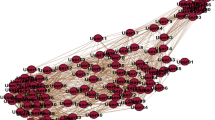Abstract
In today’s digital era, businesses try to find new clients in many ways. This study offers approaches that use graph social media analytics to identify potential clients for certain products. In this study, we consider Soft Pinch Liquid Blush. The dataset used was gathered from Twitter search queries. The main objective of this study is to discover potential customers for the product Soft Pinch Liquid Blush using graph social media analytics, as well as find significant nodes relevant to the product. The analysis starts by building a graph network with the Source and Target columns, where the Source column represents people who tweeted about the product and the Target column represents people who were referenced or reacted to a tweet, indicating prospective interest. To evaluate the influence nodes, voterank is used. Then, to find communities in the network, three graph community techniques which are Louvain, Clauset-Newman-Moore (CNM) greedy modularity and label propagation (LP) are used. The community results were compared using modularity, coverage and performance. Based on the result, node “rarebeauty” was the most influential node based on voterank. Then, Louvain algorithm detected 1265 communities, LP produced 1412 communities and CNM produced 1318 communities after applying the graph algorithms. In terms of modularity and performance scores of community structure, the Louvain and CNM algorithms appear to outperform LP algorithm. However, LP algorithm outperforms Louvain and CNM in terms of coverage. The study concludes that Louvain and CNM are the suitable algorithms in this study, even though the modularity value was low. For future research, it recommended to add more edges between nodes to increase the overall connection of the network and do network pre-processing such as noise removal, sparsity reduction and edge weight normalization to enhance the modularity score.
Access this chapter
Tax calculation will be finalised at checkout
Purchases are for personal use only
Similar content being viewed by others
References
Barnhart, B.: Everything You Need to Know About Social Media Algorithms. Sprout Social, 13 April 2022. https://sproutsocial.com/insights/social-mediaalgorithms/
Corporate Finance Institute: Engagement Rate, 11 November 2022. https://corporatefinanceinstitute.com/resources/valuation/engagementrate/
Global Marketing Guide: Potential Customers – Definition, Important, and More, 23 January 2022. https://www.globalmarketingguide.com/potential-customers/
Graph Analytics: NVIDIA Developer, 12 June 2018. https://developer.nvidia.com/discover/graph-analytics
Herman, T.: 5 Benefits of Identifying and Focusing on Your Best Customers. Veda Intell, 5 May 2022. https://www.vedaintell.com/post/5-benefits-of-identifying-and-focusing-onyour-best-customers
Jayawickrama, T.D.: Community Detection Algorithms - Towards Data Science. Medium, 29 December 2021. https://towardsdatascience.com/community-detection-algorithms-9bd8951e7dae
label_propagation_communities — NetworkX 3.1 documentation. (n.d.). https://networkx.org/documentation/stable/reference/algorithms/generated/networkx.algorithms.community.label_propagation.label_propagation_communities.html#networkx.algorithms.community.label_propagation.label_propagation_communities
Louvain method for community detection. (n.d.). https://perso.uclouvain.be/vincent.blondel/research/louvain.html
Luo, J., Ye, L.: Label propagation method based on bi-objective optimization for ambiguous community detection in large networks. Sci. Rep. 9(1) (2019). https://doi.org/10.1038/s41598-019-46511-2
Majeed, A., Rauf, I.: Graph theory: a comprehensive survey about graph theory applications in computer science and social networks. In: Inventions, vol. 5, no. 1 (2020). https://doi.org/10.3390/inventions5010010
Orman, G.K., Labatut, V., Cherifi, H.: Comparative evaluation of community detection algorithms: a topological approach. J. Stat. Mech: Theory Exp. 2012(08), P08001 (2012). https://doi.org/10.1088/1742-5468/2012/08/p08001
Singh, D., Garg, R.: NI-Louvain: a novel algorithm to detect overlapping communities with influence analysis. J. King Saud Univ. - Comput. Inf. Sci. 34(9), 7765–7774 (2021). https://doi.org/10.1016/j.jksuci.2021.07.006
Statista: Global Social Networks Ranked By Number of Users 2022, 26 July 2022. https://www.statista.com/statistics/272014/global-social-networks-ranked-by-numberof-users/
Traag, V.A., Šubelj, L.: Large network community detection by fast label propagation. Sci. Rep. 13(1) (2023). https://doi.org/10.1038/s41598-023-29610-z
Vinicius da Fonseca, V., et al.: Performance evaluation of modularity based community detection algorithms in large scale networks. Math. Probl. Eng. 2014 (2014). https://doi.org/10.1155/2014/502809
Acknowledgements
The authors would like to thank the Universiti Malaysia Pahang Al-Sultan Abdullah (UMPSA) for providing financial support under Tabung Persidangan Luar Negara (TPLN), UMPSA Grant RDU220395 and the UMPSA facilities. The authors also would like to thank the reviewers for the valuable comments for improvements for this paper.
Author information
Authors and Affiliations
Corresponding author
Editor information
Editors and Affiliations
Rights and permissions
Copyright information
© 2024 The Author(s), under exclusive license to Springer Nature Switzerland AG
About this paper
Cite this paper
Anuar, S.N.A., Muhammad, N., Firdaus, M.I. (2024). Identifying Potential Customer Using Graph Social Media Analytics. In: Arai, K. (eds) Intelligent Computing. SAI 2024. Lecture Notes in Networks and Systems, vol 1018. Springer, Cham. https://doi.org/10.1007/978-3-031-62269-4_7
Download citation
DOI: https://doi.org/10.1007/978-3-031-62269-4_7
Published:
Publisher Name: Springer, Cham
Print ISBN: 978-3-031-62268-7
Online ISBN: 978-3-031-62269-4
eBook Packages: Intelligent Technologies and RoboticsIntelligent Technologies and Robotics (R0)




